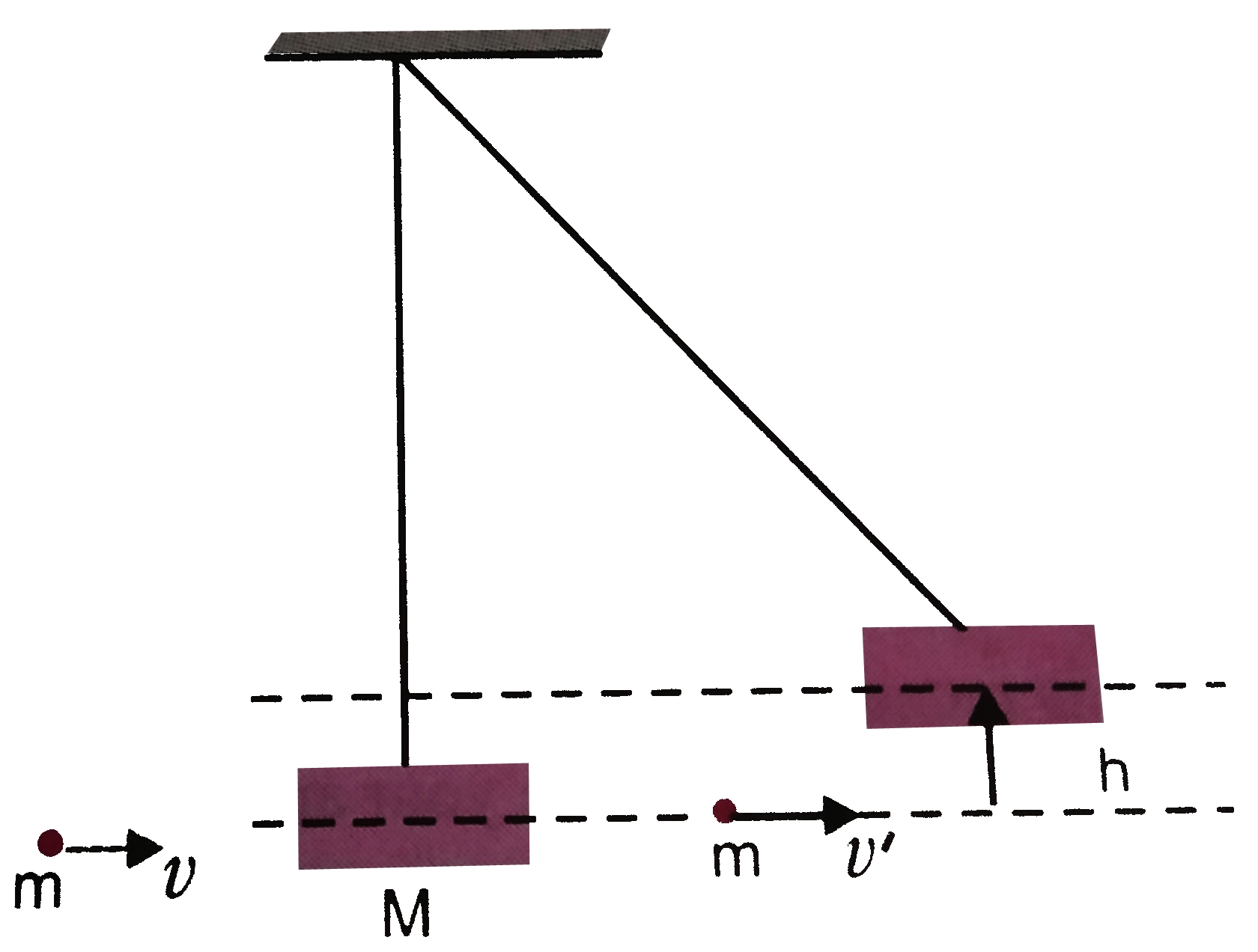A bullet of mass 0.012 kg and horizontal speed 70ms−1 strikes a block of wood of mass 0.4 kg and instantly comes to rest with respect to the block. The block is suspended from the ceiling by thin wire. Calculate the height to which the block rises. Also, estimate the amount of heat produced in the block.
To solve the problem step by step, we will follow these steps:
Step 1: Calculate the initial momentum of the bullet and the block.
The initial momentum of the bullet can be calculated using the formula:
Initial Momentum=mass of bullet×velocity of bullet
Given:
- Mass of bullet, mb=0.012kg
- Velocity of bullet, vb=70m/s
Calculating the initial momentum:
Initial Momentum=0.012kg×70m/s=0.84kg m/s
Step 2: Apply the conservation of momentum to find the final velocity V0.
The block is initially at rest, so its momentum is zero. The total initial momentum before the collision is equal to the total final momentum after the collision:
Initial Momentum=Final Momentum
0.84kg m/s=(mb+mw)×V0
Where:
- Mass of the block, mw=0.4kg
- Total mass after collision, mb+mw=0.012kg+0.4kg=0.412kg
Now, substituting the values:
0.84=0.412×V0
Solving for V0:
V0=0.840.412≈2.04m/s
Step 3: Calculate the height h to which the block rises using energy conservation.
The kinetic energy of the system after the collision will be converted into potential energy at the maximum height:
Kinetic Energy=Potential Energy
12(mb+mw)V20=(mb+mw)gh
Cancelling the mass from both sides:
12V20=gh
Solving for h:
h=V202g
Using g≈9.81m/s2:
h=(2.04)22×9.81≈4.161619.62≈0.2123m
Step 4: Calculate the heat produced in the block.
The heat produced can be calculated as the loss of kinetic energy during the collision:
Heat Produced=Initial Kinetic Energy−Final Kinetic Energy
Calculating the initial kinetic energy of the bullet:
Initial Kinetic Energy=12mbv2b=12×0.012×(70)2=12×0.012×4900=29.4J
Calculating the final kinetic energy of the combined mass:
Final Kinetic Energy=12(mb+mw)V20=12×0.412×(2.04)2=12×0.412×4.1616≈0.857J
Now, calculating the heat produced:
Heat Produced=29.4J−0.857J≈28.54J
Final Answers:
- Height to which the block rises: h≈0.2123m
- Heat produced in the block: ≈28.54J
The initial momentum of the bullet can be calculated using the formula:
Initial Momentum=mass of bullet×velocity of bullet
Given:
- Mass of bullet, mb=0.012kg
- Velocity of bullet, vb=70m/s
Initial Momentum=0.012kg×70m/s=0.84kg m/s
The block is initially at rest, so its momentum is zero. The total initial momentum before the collision is equal to the total final momentum after the collision:
Initial Momentum=Final Momentum
0.84kg m/s=(mb+mw)×V0
Where:
- Mass of the block, mw=0.4kg
- Total mass after collision, mb+mw=0.012kg+0.4kg=0.412kg
0.84=0.412×V0
Solving for V0:
V0=0.840.412≈2.04m/s
The kinetic energy of the system after the collision will be converted into potential energy at the maximum height:
Kinetic Energy=Potential Energy
12(mb+mw)V20=(mb+mw)gh
Cancelling the mass from both sides:
12V20=gh
Solving for h:
h=V202g
Using g≈9.81m/s2:
h=(2.04)22×9.81≈4.161619.62≈0.2123m
The heat produced can be calculated as the loss of kinetic energy during the collision:
Heat Produced=Initial Kinetic Energy−Final Kinetic Energy
Calculating the initial kinetic energy of the bullet:
Initial Kinetic Energy=12mbv2b=12×0.012×(70)2=12×0.012×4900=29.4J
Calculating the final kinetic energy of the combined mass:
Final Kinetic Energy=12(mb+mw)V20=12×0.412×(2.04)2=12×0.412×4.1616≈0.857J
Now, calculating the heat produced:
Heat Produced=29.4J−0.857J≈28.54J
- Height to which the block rises: h≈0.2123m
- Heat produced in the block: ≈28.54J
Topper's Solved these Questions
Similar Questions
A bullet of mass 0.01kg and travelling at a speed of 500ms−1 strikes a block of mass 2kg which is suspended by a string of length 5m. The centre of gravity of the block is found to raise a vertical distance of 0.2m. What is the speed of the bullet after it emerges from the block?
View SolutionA bullet of mass 0.02 kg travelling horizontally with velocity 250ms−1 strikes a block of wood of mass 0.23 kg which rests on a rough horizontal surface. After the impact, the block and bullet move together and come to rest after travelling a distance of 40m. The coefficient of sliding friction of the rough surface is (g=9.8ms_2)
View Solution
Knowledge Check
- Question 1 - Select One
A bullet of mass m moving horizontally with a velocity v strikes a block of wood of mass M and gets embedded in the block. The block is suspended from the ceiling by a massless string. The height to which block rises is
Av22g(mM+m)2Bv22g(M+mm)2Cv22g(mM)2Dv22g(Mm)2
A block of mass 1 kg is placed on a horizontal surface . The reaction force to the weight of the block is
View SolutionA block of mass 1kg moving with a speed of 4ms−1, collides with another block of mass 2kg which is at rest. The lighter block comes to rest after collision. The loss in KE of the system is
View SolutionA bullet of mass 0.04 kg moving with a speed of 90ms−1 enters a heavy wooden block and is stooped after a distance of 60 cm . What is the average resistive force exerted by the block on the bullet ?
View SolutionA bullet of mass 0.005 kg moving with a speed of 200 ms−1 enters a heavy wooden block and is stopped after a distance of 50 cm. What is the average force exerted by the block on the bullet?
View SolutionA bullet of mass 0.06 kg moving with a speed of 90ms−1 enters a heavy wooden block and it stopped after a distance of 60 cm. What is the average resistive force exerted by the block on the bullet ?
View SolutionA bullet of mass 10g travelling horizontally with a velocity of 150ms−1 strikes a stationary wooden block and come to rest in 0.03s. Calculate the distance of penetration of the bullet into the block. Also, Calculate the magnitude of the force exerted by the wooden block on the bullet,
View SolutionA bullet of mass 0.01 kg and travelling at a speed of 500 m/s strikes a block of mass 2 kg which is suspended by a string of length 5m. The center of gravity of the block is found to rise a vertical distance of 0.1m, figure. What is the speed of the bullet after it emerges from the block ? (g=9.8m/s2).
 View Solution
View Solution

